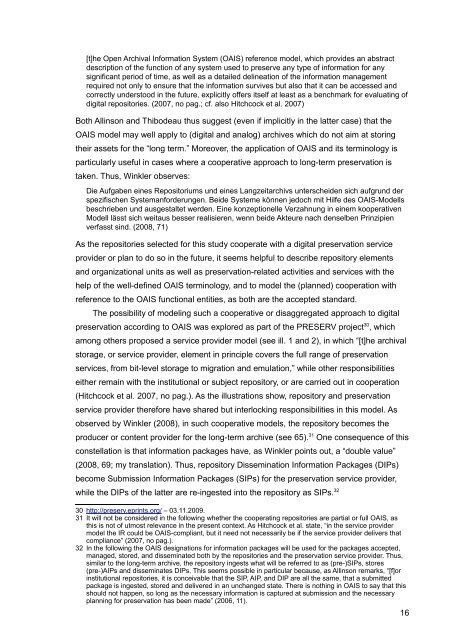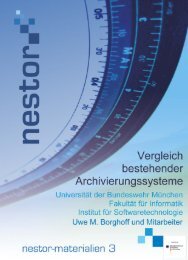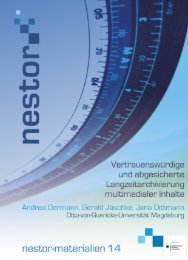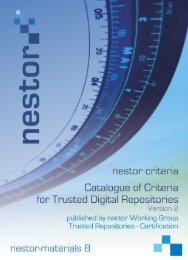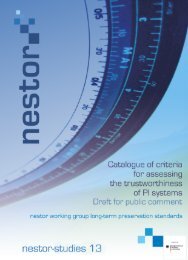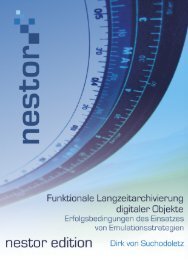Download (PDF, 9MB, Not barrier-free file.) - Nestor
Download (PDF, 9MB, Not barrier-free file.) - Nestor
Download (PDF, 9MB, Not barrier-free file.) - Nestor
- No tags were found...
Create successful ePaper yourself
Turn your PDF publications into a flip-book with our unique Google optimized e-Paper software.
[t]he Open Archival Information System (OAIS) reference model, which provides an abstractdescription of the function of any system used to preserve any type of information for anysignificant period of time, as well as a detailed delineation of the information managementrequired not only to ensure that the information survives but also that it can be accessed andcorrectly understood in the future, explicitly offers itself at least as a benchmark for evaluating ofdigital repositories. (2007, no pag.; cf. also Hitchcock et al. 2007)Both Allinson and Thibodeau thus suggest (even if implicitly in the latter case) that theOAIS model may well apply to (digital and analog) archives which do not aim at storingtheir assets for the “long term.” Moreover, the application of OAIS and its terminology isparticularly useful in cases where a cooperative approach to long-term preservation istaken. Thus, Winkler observes:Die Aufgaben eines Repositoriums und eines Langzeitarchivs unterscheiden sich aufgrund derspezifischen Systemanforderungen. Beide Systeme können jedoch mit Hilfe des OAIS-Modellsbeschrieben und ausgestaltet werden. Eine konzeptionelle Verzahnung in einem kooperativenModell lässt sich weitaus besser realisieren, wenn beide Akteure nach denselben Prinzipienverfasst sind. (2008, 71)As the repositories selected for this study cooperate with a digital preservation serviceprovider or plan to do so in the future, it seems helpful to describe repository elementsand organizational units as well as preservation-related activities and services with thehelp of the well-defined OAIS terminology, and to model the (planned) cooperation withreference to the OAIS functional entities, as both are the accepted standard.The possibility of modeling such a cooperative or disaggregated approach to digitalpreservation according to OAIS was explored as part of the PRESERV project 30 , whichamong others proposed a service provider model (see ill. 1 and 2), in which “[t]he archivalstorage, or service provider, element in principle covers the full range of preservationservices, from bit-level storage to migration and emulation,” while other responsibilitieseither remain with the institutional or subject repository, or are carried out in cooperation(Hitchcock et al. 2007, no pag.). As the illustrations show, repository and preservationservice provider therefore have shared but interlocking responsibilities in this model. Asobserved by Winkler (2008), in such cooperative models, the repository becomes theproducer or content provider for the long-term archive (see 65). 31 One consequence of thisconstellation is that information packages have, as Winkler points out, a “double value”(2008, 69; my translation). Thus, repository Dissemination Information Packages (DIPs)become Submission Information Packages (SIPs) for the preservation service provider,while the DIPs of the latter are re-ingested into the repository as SIPs. 3230 http://preserv.eprints.org/ – 03.11.2009.31 It will not be considered in the following whether the cooperating repositories are partial or full OAIS, asthis is not of utmost relevance in the present context. As Hitchcock et al. state, “in the service providermodel the IR could be OAIS-compliant, but it need not necessarily be if the service provider delivers thatcompliance” (2007, no pag.).32 In the following the OAIS designations for information packages will be used for the packages accepted,managed, stored, and disseminated both by the repositories and the preservation service provider. Thus,similar to the long-term archive, the repository ingests what will be referred to as (pre-)SIPs, stores(pre-)AIPs and disseminates DIPs. This seems possible in particular because, as Allinson remarks, “[f]orinstitutional repositories, it is conceivable that the SIP, AIP, and DIP are all the same, that a submittedpackage is ingested, stored and delivered in an unchanged state. There is nothing in OAIS to say that thisshould not happen, so long as the necessary information is captured at submission and the necessaryplanning for preservation has been made” (2006, 11).16


